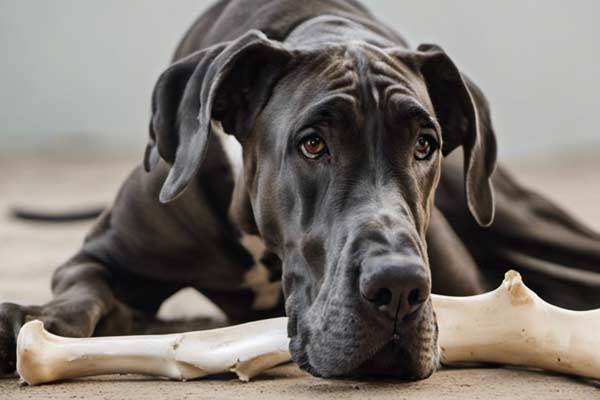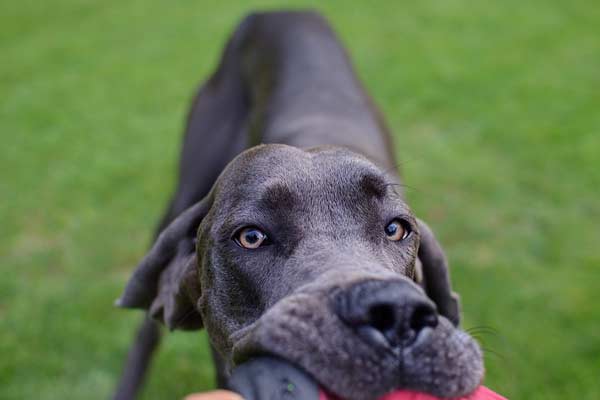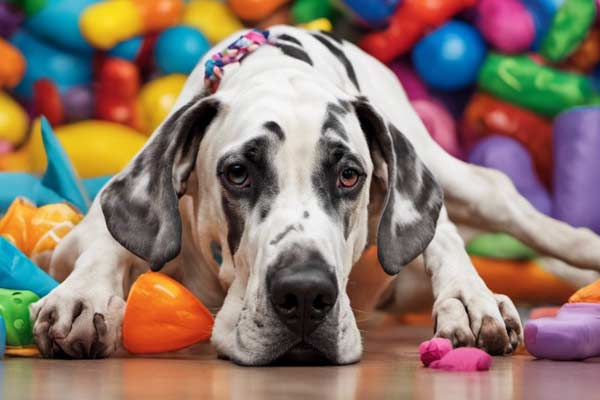Great Danes don’t need a lot of exercise, but if they don’t get enough exercise and attention, they turn to destructive chewing and destroy almost anything they can get to. Up until about three years old, the Great Danes are very boisterous and can dismay you with the sheer magnitude of their destructiveness.
Great Danes often suffer from separation anxiety, usually when they become destructive. There are ways to manage this behavior, however.
Are Great Danes Chewers?
Yes, Great Danes are chewers. Their strong jaws and teeth naturally incline them to gnaw. While they enjoy having items to chew on, their powerful jaws can lead to property damage or potential harm if they chew on dangerous things. Early training and providing ample chew toys can help manage this behavior.
What Problems Can Cause Destructive Chewing in Dogs?
When dogs are puppies, they all like to chew on things to relieve the pressure in their mouths from incoming permanent teeth. Older dogs like to chew items to keep their teeth clean and their jaws strong. Chewing is also a way that dogs deal with boredom, anxiety, and frustration.
Dogs that chew mainly when left alone or more intensely when left alone may suffer separation anxiety. Other signs include barking, pacing, whining, restlessness, and going to potty on the floor.
If your dog is overweight and on a diet with restricted calories, he may destroy and chew objects while trying to find more nutrition.
Usually, this type of destructive chewing will be on food items or items that smell like food or old food–most of the time, it’s the garbage bin.
Some dogs have a fetish, if you will, of licking, chewing, and sucking on fabric. Some experts think this is a sign that they were weaned too early as a pup.
It has become a compulsion if he exhibits this behavior for long periods, and you can’t distract him.

How to Deal With a Destructive Chewer is a Great Dane
It’s perfectly natural for dogs to chew on items, but you want your puppy to chew on only appropriate things, and this takes some training so he will know what is and isn’t on the menu.
You should put valuable items in an area where your dog can’t get to them until you know he has quit chewing inappropriate things.
Put all your jewelry in a closed box on a high shelf in your bedroom or bathroom.
Most jewelry items are small, and your dog can suffer stomach issues that warrant a trip to the emergency vet if he eats your bracelet or earrings.
Keep your shoes and clothing in a closed closet, and put your dirty laundry in a hamper where he can’t reach it. Put your books and nick-nacks unique to you on high shelves and out of reach.
Ensure your pooch doesn’t have access to any cleaning product, either. You can put child safety locks on the cabinet doors to prevent him from getting into these items that can cause him great harm by poisoning him.
Give your four-legged family member a large assortment of his toys and chew bones. Take note of the items he chews on for long periods, and be sure to keep offering those to him.
The best items for him to chew are the long-lasting ones that take up much of his time, rather than soft chews that he gobbles down within minutes.

The best idea is to rotate the toys every few days so that the toys you give him seem to be new again.
Some of the best chew toys that are long-lasting and loved by almost all dogs are nylabones, rubber balls, and rawhide chews made for chewing.
Some dogs break off pieces of a regular rawhide and then choke on them, so make sure anything rawhide that you get for your puppy is labeled as a rawhide chew.
You should look at the packaging on the toys and chews and choose items for your puppy’s age and size.
If you have an adult Great Dane and give him a toy made for a puppy, he may tear it up within a minute or two and eat the stuffing out of it or the squeaker.
Many of the best items for your Great Dane are labeled for aggressive chewers, which are ideal because they are long-lasting.
Don’t give your buddy any cooked bones to chew on; instead, give him natural dog bones for chewing. Offer edible things to your dogs, such as pig ears, rawhide bones, bully sticks, or other natural chews.
Ensure he can relax while chewing on these items so he doesn’t bite off a large chunk and choke on it.
This can happen more often if other dogs are in your household and your Great Dane thinks he needs to gobble up his chew before the other dog can get it.
If you notice a specific time of the day that your pooch designates as chew time, then offer him a chew toy or a puzzle toy filled with doggie treats at this time of the day.
Most of the time, it’s a specific time of the day when your puppy decides to chew up items, usually before he has had his meals and some exercise.
Discourage your dog from chewing the wrong items with a chewing deterrent. Apply a small amount of it to a piece of tissue and put it in your dog’s mouth.
He will connect the smell of the deterrent with a nasty flavor to avoid items that have that smell. Spray your furniture, rugs, and other items in the home daily for two to four weeks.

At this time, your puppy will most probably have learned he doesn’t want to chew those items.
Great Danes are intelligent and learn things much quicker than other dog breeds.
Keep a close eye on your dog, and if you see him chewing something he shouldn’t, tell him “no,” take the item out of his mouth, and give him one of his chew bones or toys instead. Then, praise him for chewing on the correct type of item.
If you spend most of the day away from home to go to school or work, you can put your dog in a bathroom where you’ve sprayed the chewing deterrent on items you don’t want destroyed.
Putting the toilet paper in a cabinet with a child safety lock on it is also a good idea, as puppies and dogs love tearing up your toilet tissue. Close the door so he is contained in this area, and leave him an ample supply of appropriate chewing items.
This will keep him from tearing up household items throughout the home. You can instead put your dog in the kitchen with a gate across the opening so he has a larger space to be in while you are away from home.
Make sure to take him outside for a potty break before you leave to lessen the chance of accidents on the floor.
Make sure your dog gets plenty of playtimes and physical exercise. He should also have mental stimulation, such as puzzle toys, training sessions with you, and social interactions with others.
Make sure that he gets exercise before you need to leave him home alone. A tired dog is a good dog.
Supply Him With Exercise and Mental Stimulation
Most dogs that get bored will turn to destructive chewing when left alone. Walk your dog daily and offer him off-leash time to play with other dogs at the park.
Play tug and fetch with him, and you can enroll him in clicker training classes and dog sports classes, such as flyball, freestyle, or agility. It also stimulates his mind to offer him food or treats in a puzzle toy.
Leave Your Scent At Home
Before leaving your Great Dane alone at home, rub one or more of his toys or chews between your hands to leave your scent on it. This can soothe your puppy and avoid destructive chewing.
You can leave the television or radio on for him and don’t make a big deal of it when you leave the house because this can give him separation anxiety.
Final Thoughts
Reinforce good chewing behaviors with a lot of praise, and try not to scold your furry friend too much if he makes a mistake and chews up your furniture while he’s still learning what is appropriate to chew.
